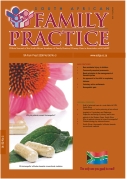Characteristics of Acute Poisoning at Two Referral Hospitals in Francistown and Gaborone
Keywords:
poisoning,
Abstract
Background: The epidemiology of acute poisoning in Botswana is not well established due to the limited availability of published data. In an attempt to fill this gap, this study aimed to characterise acute poisoning cases admitted to two urban hospitals in Francistown and Gaborone, Botswana. Methods: This study followed a descriptive methodology involving 116 patients with the primary diagnosis of acute poisoning admitted to two referral hospitals in Botswana from January to June 2005. Data were collected by means of a pre-tested data-collection form. Results: Overall, 58 (50%) of the victims of acute poisoning were female, accidental poisoning occurring in 89 (76.9%) of the cases. Intentional poisoning was reported in 33.3% of the females versus 13.5% of the males. With regard to demographic distribution, the majority of the victims were in the age category of 13 to 19 (20.7% versus 5.2%) for the females and in the 30-year-old group for the males (24.1% versus 10.3%). Poisoning by household chemicals, particularly paraffin, affected mainly children under 12, while poisoning by pharmaceuticals involved mainly teenagers. With regard to outcomes, three of the female victims died, representing a case fatality rate of 2.6%. One death was due to paraffin poisoning and two to traditional medicine. Those who died were two children in the 0 to 12-year group and one adult in the age category of 20 to 30. Conclusion: The acute poisoning involved a variety of toxic agents of which household chemicals and pharmaceuticals predominated. Differences based on age category, sex, the types of toxic agents involved and the outcomes of the poisoning incidents were noted. Future interventions should take these differences into account.
Published
2008-03-26
Section
Original Research
By submitting manuscripts to SAFP, authors of original articles are assigning copyright to the South African Academy of Family Physicians. Copyright of review articles are assigned to the Publisher, Medpharm Publications (Pty) Ltd, unless otherwise specified. Authors may use their own work after publication without written permission, provided they acknowledge the original source. Individuals and academic institutions may freely copy and distribute articles published in SAFP for educational and research purposes without obtaining permission.

